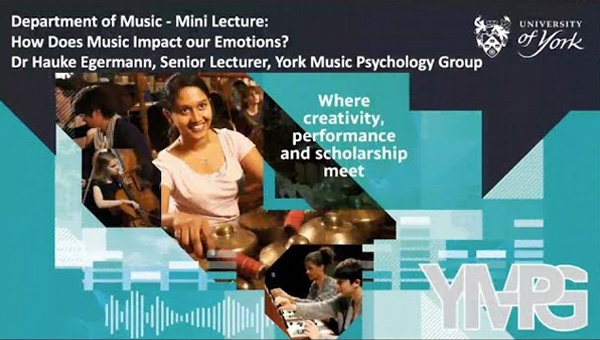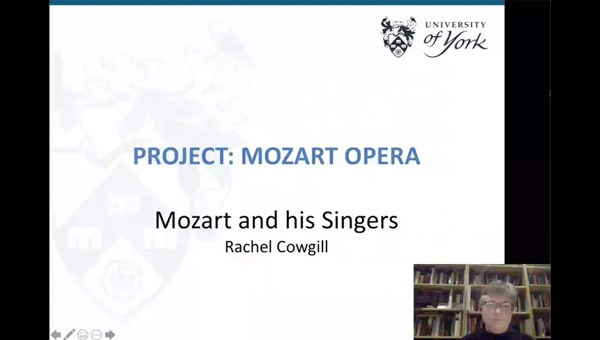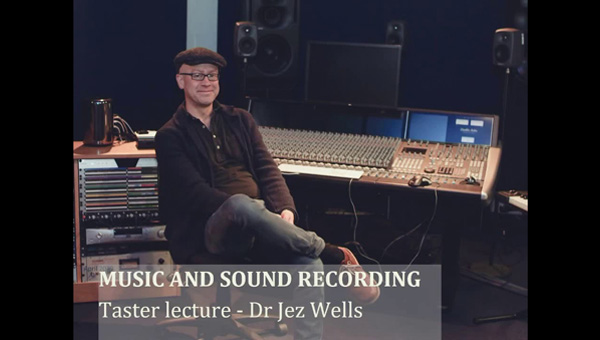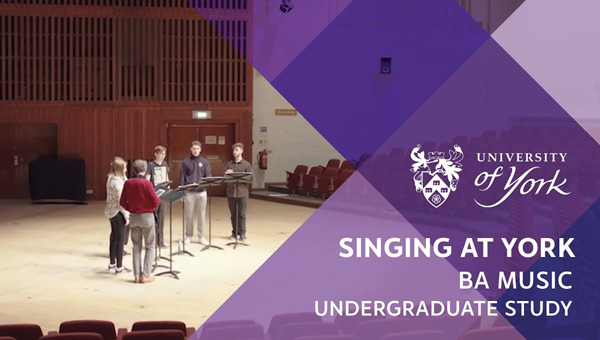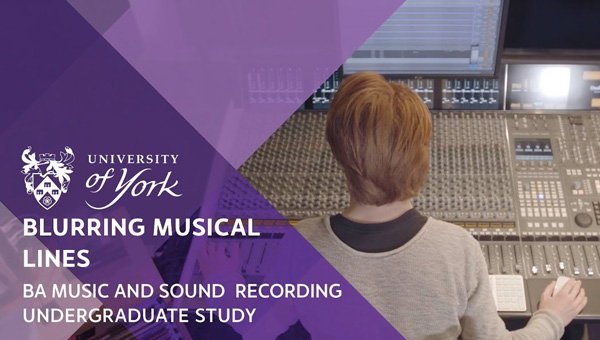Pre-arrival information for Music undergraduates
Welcome and congratulations on receiving an offer! We're looking forward to welcoming you soon.
We've put together some resources to help you prepare to study with us, including videos about our courses and life in our School, and samples of current undergraduate teaching.
Preparing to study
We deliberately don’t provide a set 'prior reading list' because we recognise that students come to us with a huge variety of musical experiences and interests. We try to give you space within our programme to develop those interests further through our range of option modules, as well as pointing you towards new things to get excited about too.
None of the below are things we’d necessarily 'expect' an average student to have read or done upon arrival with us (as far as we are concerned there’s no such thing as an 'average student' anyway - all our students are gloriously individual). If there is something musical you’ve been longing to do for ages - learning to play a particular piece, getting to know a composer or musician’s output really well, getting to grips with MIDI controllers - ignore this list and do that instead; we’ll be delighted to hear about it when you join us.
But if you’re stuck for ideas, or just want suggestions for even more things you could be doing, here are a few starting points.
BA Music
Many of these are available cheap second-hand; if you can’t find a cheap copy on Amazon it’s also worth searching the very comprehensive price-comparison site bookfinder.
- Nicholas Cook’s Music: A Very Short Introduction is a great starting point for the kinds of issues you might cover at university. (If you’ve not heard of the Very Short Introductions series, it’s a great way to get started on a specific topic; they actually cover various other musical topics too, including ethnomusicology, folk music, early music and music psychology…)
- A slightly more in-depth guide is the edited volume An Introduction to Music Studies (ed. JPE Harper-Scott and Jim Samson) – it’s helpfully organised by subdiscipline so you can focus on the sections that interest you.
- If you feel that your theory or analytical skills need a bit of brushing up, there are various texts you could work through depending on your current level. Anna Butterworth’s Harmony in Practice takes you through to about grade 8 theory in carefully-guided exercises and examples; George Pratt’s The Dynamics of Harmony goes a bit further and considers the broader principles of harmony. If you’re already quite comfortable with those ideas, Nicholas Cook’s A Guide to Musical Analysis is a great overview of analytical techniques that also considers atonal and other non-traditional music.
- There are also some excellent open-access websites that give you these ideas for free, structured so you can easily find the bits you don’t already know: Open Music Theory, Sound Patterns, and Music Theory for the 21st-Century Classroom are particularly comprehensive and well-organised.
This is one of the best things you can do to prepare for university music studies. Listening thoughtfully and analytically is a core skill for any university-level music student. So do make the time to listen through to things you’ve not encountered yet, especially big pieces (and especially big orchestral pieces). Above all, just listen to anything you’ve not heard before. A few specific tips to help you develop your musical listening skills:
- Set aside regular time to listen attentively to new things (ie doing nothing else, just listening). 10 minutes a day is a good habit to get into. Have a master list of new things you want to listen to that can feed into this time.
- A good way to help you listen thoughtfully is to keep a 'listening diary': list each piece as you listen to it, and jot down any ideas/questions you have while listening. Some things you’ll really enjoy, and others you might not – try and ask yourself what it is about the music that makes you respond in this way. It’s okay not to enjoy something, but it’s good to be able to reflect on why that is!
- Follow along with the scores – lots of pre-1900s (and some post-1900s) music can be downloaded free from IMSLP.org as it’s out of copyright. A lot of more recent music (especially by living composers) can be viewed legally on publishers’ websites: check out Faber Music (navigate to a composer to look at their scores, including our very own Martin Suckling), ScoresOnDemand, and Boosey & Hawkes.
- You might also want to use this time to familiarise yourself with composers whose music has been sidelined historically for ideological reasons – such as the African-American composers William Dawson, Florence Price and William Grant Still, all of whom wrote fantastic symphonies within a few years of each other in the 1930s. The question of how we decide what the 'great' pieces of music are, and who gets left out of that category (and why), is one that comes up a lot at university level.
- Spotify, YouTube and SoundCloud are all useful streaming services, but don’t forget that you can just put on the radio (eg Radio 3) for a few minutes to listen attentively to whatever is on.
As well as reading and listening, there are some practical tasks you can do to help you prepare for your time at the University of York.
- Sing along with I Fagiolini’s series of free 'Sing the Score’ videos – miniature choral and vocal masterworks with onscreen scores. Featuring our very own Robert Hollingworth and many other friends of Music at York!
- Look for ways you can apply the things you are reading practically. For example, if you’re reading about theory/analysis, the best way to get to grips with it is to pick a few pieces to analyse, and then just do it as you go. If you hit something you don’t understand harmonically or structurally, go back to the textbooks and try and figure it out. Use the analysis as a way of helping you understand the effect of the music – that’s what it’s there for. Analysis starts with listening.
- You could put together a multicam performance yourself! There are a few simple apps to help, or if you’re quite tech-savvy you could download the free professional video editor Da Vinci Resolve and really go to town (it’s pretty complex software but there are some very good video tutorials available). Now is a good time to get to grips with whatever software you might be using musically at university. From a sound-recording point of view, getting hold of Reaper is a great idea (they have a free 60 day trial and are very reasonably priced) – it is something of a learning curve but is hugely capable once you get to know it.
BA Music and Sound Recording
Many of these are available cheap second-hand; if you can’t find a cheap copy on Amazon it’s also worth searching the very comprehensive price-comparison site bookfinder.
- Nicholas Cook’s Music: A Very Short Introduction is a great starting-point for the kinds of issues and material you might cover at university. (If you’ve not heard of the Very Short Introductions series, it’s a great way to get started on a specific topic; they actually cover various other musical topics too, including ethnomusicology, folk music, early music and music psychology…)
- There are a few textbooks that you might find very helpful during your time here. We have several loanable and reference copies in our library, but if you want to get a copy yourself we would recommend Sound & Recording by Rumsey and McCormick (a really wide-ranging book that covers most aspects of sound recording).
- Acoustics and Psychoacoustics by Howard and Angus covers any and all physics you would ever need in sound recording. Again, we have several loanable and reference copies in our library if you don’t have your own.
- If you feel that your theory or analytical skills need a bit of brushing up, there are various texts you could work through depending on your current level. Anna Butterworth’s Harmony in Practice takes you through to about grade 8 theory in carefully-guided exercises and examples; George Pratt’s The Dynamics of Harmony goes a bit further and considers the broader principles of harmony. If you’re already quite comfortable with those ideas, Nicholas Cook’s A Guide to Musical Analysis is a great overview of analytical techniques that also considers atonal and other non-traditional music.
- Listening thoughtfully and analytically is a core skill for any university-level music student. So do make the time to listen through to things you’ve not encountered yet. Listening to classic solo pieces, large orchestral pieces, experimental works, live recordings, modern pop, and dub will prepare you particularly well for some of the topics we cover. Above all, just listen to anything you’ve not heard before.
- A good way to help you listen thoughtfully is to keep a ‘listening diary’: list each piece as you listen to it, and jot down any ideas/questions you have while listening. Some things you’ll really enjoy, and others you might not – try and ask yourself what it is about the music that makes you respond in this way. It’s okay not to enjoy something, but it’s good to be able to reflect on why that is! Even just 2 or 3 new tracks a day is enough to really start expanding your reference points and your knowledge.
- We’ve created a Spotify playlist specifically for you to help you get to grips with the range and depth of some of the music and technologies you might encounter while you’re here at York. You don’t have to like it (even a negative reaction is one worth discussing!) but everyone should hear this music at least once.
- From early in the very first module we’ll be exploring frequency (pitch). Good engineers are expected be able to estimate a frequency accurately. To do this takes practice and training. This handy tool allows you to set your level and increase the difficulty over time. If you can score 50% on the ‘guru’ level you’re doing very well indeed. Why not train up before you arrive?
As well as reading and listening, there are some practical tasks you can do to help you prepare for your time at the University of York.
- Build a reference bank – when we are recording or mixing we will need to listen to our work constantly to check the quality of it. However, we may work on a range of different equipment, monitor speakers, and microphones depending on the situation. It helps to have reference tracks we know the sound of really well, so we can listen to those on any system and hear how the system reproduces the sound. We recommend building a bank of reference tracks you know very well in a range of styles you can use in the studio.
- Top tip from one of our tutors: One of mine is a Spice Girls track: the hi-hat is far too loud, so if it sounds good in a studio I know the speakers aren’t reproducing some frequencies very well.
- Get software-ready – while not essential, there are several free/open source software tools that we recommend to make your life easier. We suggest signing up for a free Spotify account (we share some extra listening material on Spotify for home listening), and ensuring you have Chrome and Firefox for dealing with high quality web audio. You will also be working on Reaper for your first module so we suggest installing this before you arrive. Reaper offers a 60 day evaluation trial, so you should not pay for Reaper at this stage.
- Reaper training – as it is easy to programme, offers high quality reproduction, and is highly flexible, we have standardised Reaper as the primary recording software in all studios in the Music department. As such we recommend students do some preparatory work in learning the basic functions of Reaper. Cockos (the company behind Reaper) provide excellent introductory and explanatory videos. We recommend you begin with the 'How to Watch the REAPER Videos (New Users)' clip and then move onto the 'This is REAPER 6' videos, starting with 'Introduction'. This will give you a great advantage when beginning your first recordings in your first MASR module. Don’t worry, you can use whatever DAW you like for most modules, this is just how we start your training.
- Start a portfolio – collecting any previous recording, sequencing or mixing work you’ve done is a great way to consolidate the work you’ve already done to get here. Being able to refer to your previous work is very helpful when it comes to analysing and identifying your own progress. It might even feed into some of the careers activity we do. It's always good to have a solid backup of any and all work you’ve done.
Taster lectures
Get a taste of our teaching with our sample lectures, taken from our current undergraduate modules.
